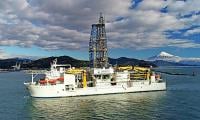Deathtrap
A methane deathtrap – continuing Arctic Ocean eruption of ever-increasing levels of methane brings forth speculation of a ‘Black Swan Event’, meaning society is caught flat-footed oblivious to impending danger until it’s way too late.
Along those lines, The Economist newspaper only recently highlighted the methane issue for its mainstream readership. ‘The Methane Mystery: Scientists Struggle to Explain a Worrying Rise in Atmospheric Methane’, The Economist, April 28th 2018: “Keeping methane in check is therefore critical if a rise in temperature this century is to remain ‘well below’ 2°C relative to pre-industrial times, a goal set out in the Paris climate agreement of 2015… The explanations put forward by scientists range from the troubling to the truly hair-raising.” (Ed.-“Hair-raising” 100% correct.)
Climate scientists have long sighted methane bubbles rising to the surface in the Arctic for well over one decade now, especially along the East Siberian Arctic Shelf (ESAS). Problem: Methane eruptions are gradually turning into virtual monsters, getting bigger and wider (up to a half-mile across of rippling bubbles, according to Russian scientists), and potentially more dangerous and destructive, expanding more and more, in anticipation of a gigantic methane burp (maybe 50 gigatons suddenly vs only 5 gigatons now in the atmosphere) followed by a massive global self-reinforcing planetary heat stroke.
At that point in time, The Economist’s ‘methane mystery’ reference will be solved via The Full Monty as methane takes a “selfie” in the form of a 50-gigaton burst. Not pretty!
Unquestionably, methane could be a significant disruption to commonly accepted democratic, and autocratic, but especially democratic lifestyles, as well as one of the least understood threats in all of history, a dreaded ‘Black Swan Event’, or, in essence, a virtual deathtrap.
Meantime, mainstream science is behind the ‘eight ball’ re Arctic methane. According to an article in the American Association for the Advancement of Science (“AAAS”), the Intergovernmental Panel on Climate Change (IPCC) claims Arctic methane will be “insignificant” throughout the century, as stated: “The IPCC considers the potential contribution of the ESAS into the emissions of CH4 as insignificant.” (Source: Russian Scientists Deny Climate Model of IPCC, Tomsk Poytechnic University, AAAS, 15 Aug 2017)
What if the IPCC is dead wrong, thus misleading the public head first into a ‘Black Swan Event’, blindsided by one of the biggest potential human disasters in all history, maybe sooner rather than later.
All of which begs a multi-part question: How can scientists in a worldwide forum, like the IPCC, be so far off base, or is today’s scientific methodology inherently weak, or is the entire climate change scenario simply too vast for effective scientific coverage, or is the ESAS methane threat not that imposing? Nobody knows for sure.
Yet, Russian data on seabed methane concludes that the East Siberian Arctic Shelf shows “… the roof of the subsea permafrost had already reached the depth of hydrates’ stability the destruction of which may cause massive releases of bubble methane,” Ibid.
This article has been excerpted from: ‘Methane Deathtrap Threatens Democracy’.
Courtesy: Counterpunch.org
-
 Jason Momoa Cherishes Hosting Ozzy Osbourne's Final Gig Ahead Of His Death
Jason Momoa Cherishes Hosting Ozzy Osbourne's Final Gig Ahead Of His Death -
 Real Reason Timothee Chalamet Thanked Kylie Jenner At Awards Revealed
Real Reason Timothee Chalamet Thanked Kylie Jenner At Awards Revealed -
 Will King Charles Attend Funeral Of Prince Philip's First Cousin, Princess Irene?
Will King Charles Attend Funeral Of Prince Philip's First Cousin, Princess Irene? -
 'Furious' Prince William Wants Andrew As Far Away As Possible
'Furious' Prince William Wants Andrew As Far Away As Possible -
 Blood Moon: When And Where To Watch In 2026
Blood Moon: When And Where To Watch In 2026 -
 Apple Foldable IPhone Tipped For 2026 Launch With A20 Pro Chip And C2 Modem
Apple Foldable IPhone Tipped For 2026 Launch With A20 Pro Chip And C2 Modem -
 Meghan Lends Credence To Reports Of Rift With Kim Kardashian On Chicago's Birthday
Meghan Lends Credence To Reports Of Rift With Kim Kardashian On Chicago's Birthday -
 Florida Woman’s Alleged Bid To Bribe Police Ends In Unexpected Discovery
Florida Woman’s Alleged Bid To Bribe Police Ends In Unexpected Discovery -
 James Van Der Beek Strongly Opposes The Idea Of New Year In Winter
James Van Der Beek Strongly Opposes The Idea Of New Year In Winter -
 Elon Musk’s Starlink Rival Eutelsat Partners With MaiaSpace For Satellite Launches
Elon Musk’s Starlink Rival Eutelsat Partners With MaiaSpace For Satellite Launches -
 Fans Feel For Leonardo DiCaprio As He Gets Awkwardly Snubbed: Watch
Fans Feel For Leonardo DiCaprio As He Gets Awkwardly Snubbed: Watch -
 Japan Launches The World’s First Trial To Extract Rare Earth Elements
Japan Launches The World’s First Trial To Extract Rare Earth Elements -
 Prince Harry Breaks Cover In California Amid Tension At Home With Meghan Markle
Prince Harry Breaks Cover In California Amid Tension At Home With Meghan Markle -
 ASAP Rocky Makes Massive Comeback With New Album
ASAP Rocky Makes Massive Comeback With New Album -
 Amanda Seyfried Unveils How Channing Tatum Teased Her On 'Dear John' Set
Amanda Seyfried Unveils How Channing Tatum Teased Her On 'Dear John' Set -
 Blue Moon 2026: Everything You Need To Know
Blue Moon 2026: Everything You Need To Know



